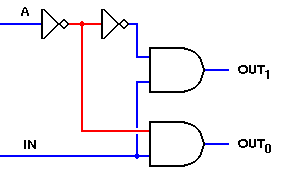
This circuit uses the same AND gates and the same addressing scheme as the two-input multiplexer circuit shown in these pages. The basic difference is that it is the inputs that are combined and the outputs that are separate. By making this change, we get a circuit that is the inverse of the two-input multiplexer. If you were to construct both circuits on a single breadboard, connect the multiplexer output to the data IN of the demultiplexer, and drive the (A)ddress inputs of both circuits with the same signal, you would find that the initial X0 input would be transmitted to OUT0 and the X1 input would reach only OUT1.
The one problem with this arrangement is that one of the two outputs will be inactive while the other is active. To retain the output signal, we need to add a latch circuit that can follow the data signal while it's active, but will hold the last signal state while the other data signal is active. An excellent circuit for this is the D (or Data) Latch. By placing a latch after each output and using the Addressing input (or its inverse) to control them, we can maintain both output signals at all times. If the Address input changes much more rapidly than the data inputs, the output signals will match the inputs faithfully.